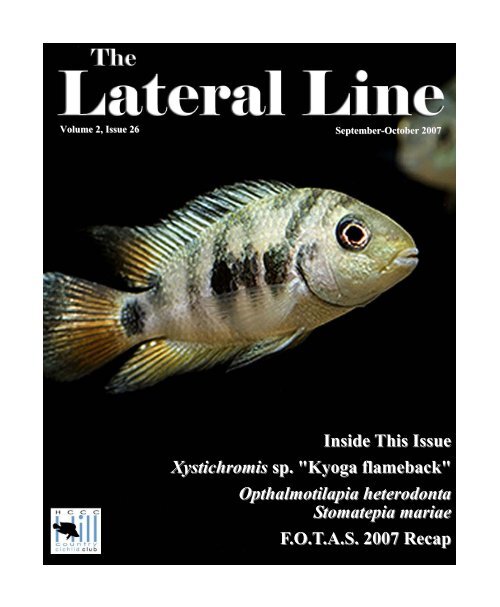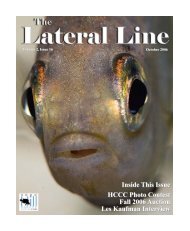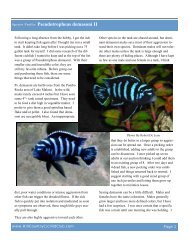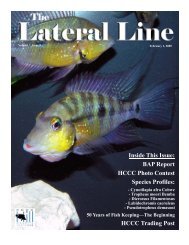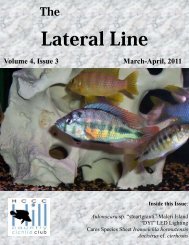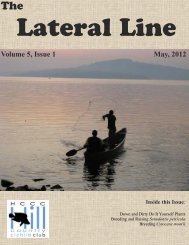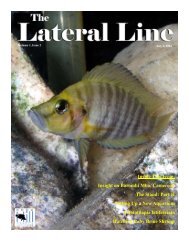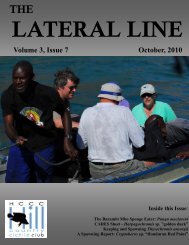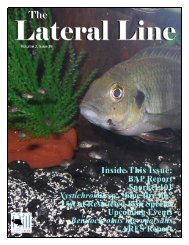September/October - Hill Country Cichlid Club
September/October - Hill Country Cichlid Club
September/October - Hill Country Cichlid Club
Create successful ePaper yourself
Turn your PDF publications into a flip-book with our unique Google optimized e-Paper software.
Volume 2, Issue 26<br />
<strong>September</strong>-<strong>October</strong> 2007<br />
Inside This Issue<br />
Xystichromis sp. "Kyoga flameback"<br />
Opthalmotilapia heterodonta<br />
Stomatepia mariae<br />
F.O.T.A.S. 2007 Recap
The Lateral Line Page 2<br />
BAP Report<br />
August entries contained a month of firsts. Congratulations to Kevin<br />
(Sir BlackhOle) on his 1st of species spawning of Parachromis<br />
managuensis. This is a very large fish and his article on the caring<br />
and breeding of this species should be very interesting. Congrats<br />
Kevin.<br />
<strong>October</strong> 10, 2007<br />
INSIDE THIS<br />
ISSUE:<br />
X. sp. "Kyoga flameback" 4<br />
Opthalmo. heterodonta 7<br />
F.O.T.A.S. 2007 10<br />
Stomatepia mariae 16<br />
Upcoming Events 19<br />
Another 1st of species entry was submitted by Kenneth (Shelload)<br />
on the Dimidiochromis compressiceps. Kenneth entered the BAP in<br />
March and this is his 3rd entry of a 1st of species. Most important<br />
was the fact that this was his 5th entry into the program and qualifies<br />
him for the Breeders Award. Great work Kenneth on your accomplishments.<br />
Although the fry are 2 months old they still may be too<br />
small for transporting, but check with him. Kenneth also submitted<br />
two more entries, the Labidochromis caeruleus and the Aulonocara<br />
hueseri. Congrats Kenneth on your entries, keep them fry coming.<br />
It would not be a BAP month if we did not hear from Greg (GAS).<br />
And he has not disappointed us by entering another 1st of species.<br />
Congratulations on the Ctenochromis horei, which is a large and<br />
aggressive fish. If you're interested in the fry be prepared to have a<br />
large tank and plenty of refuge for the females. Congratulations<br />
Greg.<br />
Congratulations go out to Dan (dwschacht) on his first entry in the<br />
BAP. His first entry consisted of two entries, one was the Labidochromis<br />
caeruleus and the other was the Pseudotropheus acei, white<br />
tail. Congrats again Dan on your first two entries in the BAP.<br />
Cover Photo:<br />
Archocentrus sp.<br />
“Honduran Red<br />
Point”<br />
By Dave Hansen<br />
Congrats to all the 1st for August. <strong>September</strong> will host a 1st for the<br />
HCCC with the upcoming FOTAS Convention. Hope to see you<br />
there.<br />
Standings on Page 19.<br />
■ Jim Beck
The Lateral Line Page 3<br />
HCCC Monthly Photo Contest<br />
First Place<br />
Dave Hansen<br />
Benitochromis nigrodorsalis<br />
Second Place<br />
Dave Hansen<br />
Pseudocrenilabrus multicolor<br />
multicolor<br />
Thrid Place<br />
Dave Hansen<br />
Steatocranus gibbiceps
The Lateral Line Page 4<br />
Species Profile:<br />
Xystichromis sp. "Kyoga flameback"<br />
The Kyoga Basin in Uganda is a large portion<br />
of the Victorian Nile drainage system. Situated<br />
North of Lake Victoria, Lake Kyoga is the<br />
main body of water with many surrounding<br />
shallow bays and isolated finger-lakes. Lake<br />
Nawampassa is situated in the south east portion<br />
of this region and is separated from the<br />
main Kyoga waters by a thin strip of swamp.<br />
Lake Nawampassa is home not only to species<br />
found throughout the Kyoga Basin, but also to<br />
several endemics. Due to environmental fragility,<br />
all species from this region are considered<br />
threatened. Most of the cichlid lineages found<br />
in Lake Victoria have representatives in the<br />
Kyoga region and into Nawampassa.<br />
For the hobbyist, the furu from Kyoga are<br />
sought after due to their small size, adaptability<br />
to captive life and coloration (they are among<br />
the most colorful cichlids on the planet). These<br />
fish are not regularly seen at your local store so<br />
it may take some effort and digging to locate<br />
them. One such species is the vibrant Xystichromis<br />
sp. "Kyoga flameback".<br />
This species was first discovered in Lake<br />
Nawampassa by Julian Whitehead (in all<br />
probability) and later located by Les Kaufman,<br />
who gave this species the cheironym<br />
"Kyoga flameback". This may be a misnomer<br />
as it is uncertain if the Kyoga Flameback is<br />
actually found in Kyoga proper. X. sp.<br />
"Kyoga flameback' is not to be confused with<br />
Xystichromis sp. "flameback" that was discovered<br />
at Kisumu Kenya in 1989 by Dr. Kaufman.<br />
The latter species has a wide distribution<br />
within Lake Victoria and sports differing<br />
body markings. The Victorian flameback is a<br />
smaller species and a generalized feeder as is<br />
its Nawampassian cousin. To add to the confusion<br />
level, X. sp. "Kyoga flameback" is<br />
known by the trade name Haplochromis sp.<br />
"all red" Nawampassa. This cichlid is sometimes<br />
confused with Haplochromis sp. "all<br />
red" from Lake Edward. I feel that to avoid<br />
unnecessary misidentifications, one should<br />
refer to the fish as X. sp. "Kyoga flameback"<br />
(the original field name) and drop the<br />
other monikers.<br />
Dave’s Rare Aquarium Fish<br />
a proud supporter of the HCCC<br />
5121 Crestway Drive Suite 300<br />
San Antonio, TX 78239 (210) 599-9444<br />
Member discounts<br />
www.DavesFish.com<br />
Xystichromis sp. "Kyoga flameback" has<br />
an elongated, laterally compressed<br />
"haplochromine" body shape. The cranial<br />
profile is straight or slightly convex<br />
with large eyes and a medium sized<br />
mouth. There is a broken and thickened<br />
mid lateral black bar running the length<br />
of the body from the caudal peduncle to<br />
the gill plate. In regards to male coloration,<br />
the top portion of the body, includ-
The Lateral Line Page 5<br />
ing the head is scarlet red. The lips and lower<br />
portion of the head is blue. The bottom portions<br />
of the flanks are lime-green and yellow.<br />
The dorsal fin is red foremost fading to blue at<br />
the rear while the caudal fin has blue streaks at<br />
the base flowing to completely red at the extremities.<br />
The anal fin is white-blue becoming<br />
red at the outer portion. The pelvic fins are jetblack.<br />
There is a straight black bar beginning<br />
at the corner of the lips and continuing through<br />
the eye. Female coloration is an<br />
unassuming tan-brown with the<br />
same markings found on the<br />
males. The lower jaw protrudes<br />
slightly beyond the upper. Bicuspid<br />
dentition is found in all but<br />
large adult males who show some<br />
unicuspid teeth in the outer rows.<br />
Wild populations are opportunistic<br />
insectivores who diet also consists<br />
of plant matter. Both sexes<br />
have an adult size of 12cm. These<br />
aspects are all consistent with the<br />
genus Xystichromis. Further research<br />
may result in a different or<br />
completely new designation, but for the time<br />
being, this seems to be the best fit.<br />
Xystichromis sp. "Kyoga flameback", is for the<br />
most part, a peaceful aquarium resident. Males<br />
will become aggressive among each other with<br />
the onset of spawning but in general remains<br />
rather placid. Despite its size (comparatively<br />
speaking) the Kyoga flameback can be easily<br />
bullied by other species so care and observation<br />
is crucial when choosing tank mates. I have<br />
been able to maintain the oral shellers with X.<br />
sp. "Kyoga flameback" devoid of incident.<br />
These species include Ptyochromis sp.<br />
"salmon", Platytaeniodus sp. "redtail sheller",<br />
and Haplochromis sp. "Kenya gold". I have<br />
tried working Pundamilia pundamilia and<br />
Pundamilia sp. "blue bar" in the mix but I<br />
believe these to be a little too boisterous and<br />
the X. sp "Kyoga flameback" failed to fully<br />
color.<br />
To successfully maintain X. sp "Kyoga flameback",<br />
one should house a colony in a tank of<br />
Photo by Dave Hansen<br />
no less that 40 gallons, preferably larger. A<br />
sand or small grain gravel substrate is favored<br />
as this cichlid enjoys "scooping" at the bottom<br />
while sifting for food. This vertical "head<br />
plunging" is a constant leisure activity. I employ<br />
some rockwork into all my tanks but this<br />
is for pure aesthetics as X. sp "Kyoga flameback",<br />
when content with its environment,<br />
prefers open areas. As with all responsible<br />
aquatic husbandries, adequate filtration and<br />
frequent water changes are required to keep<br />
this fish, as well as all others, in prime condition.<br />
Feeding should consist of a high quality
The Lateral Line Page 6<br />
flake containing both protein and vegetable<br />
matter although a diet of spirulina flake with<br />
frozen or live brine shrimp, daphnia, or the<br />
like, is also suitable.<br />
At 6cm, males will begin to display the red<br />
coloration for which they are known. This<br />
usually occurs at seven months of age. Male<br />
coloration indicates sexual maturity so the first<br />
attempt at spawning takes place soon there<br />
after. The act of spawning is typical of the<br />
Photo by Dave Hansen<br />
haplochromines from the region. The males<br />
color intensifies while claiming and defending<br />
a small territory. This region is concentrated<br />
around some object (usually a rock). The male<br />
will dart at the ripe female and dance tilted to<br />
one side displaying his fully extended fins. She<br />
will eventually enter his territory and the two<br />
will begin circling each other. The male tilts so<br />
that his anal fin is laying on the substrate. The<br />
ocelli resemble the female's eggs in both color<br />
and size. As she nips at the egg spots, the male<br />
releases milt. She drops a small number of<br />
eggs and quickly turns to pick them up into<br />
her mouth. This process continues until she<br />
has fully expelled. She then leaves the spawning<br />
area to find a quiet area in which to brood<br />
her clutch. After 18 days (gestation period is<br />
dependant on water temperature) the larvae<br />
have fully absorbed their egg sac and the female<br />
releases her fry for a short spurt, to forage.<br />
Over the next two weeks the female releases<br />
her brood more often scooping them<br />
back into her buccal cavity when<br />
she feels they are in danger. The<br />
young will eventually be left to fend<br />
for themselves. Brood sizes are<br />
large and can number in excess of<br />
50. To ensure survival, we raise the<br />
fry in a separate tank where they<br />
grow quickly on a diet of finely<br />
crushed flake and Cyclop-eeze®.<br />
Xystichromis sp. "Kyoga flameback"<br />
is rarely seen commercially in<br />
the aquarium hobby. If one is interested<br />
in obtaining a group to work<br />
with, I would suggest seeking a<br />
private breeder of commendable reputation. It<br />
may well take a lot of searching but the end<br />
result will be well worth the effort. These fish<br />
are a stand out in any aquarium they inhabit.<br />
Maintaining the Kyoga flameback will not<br />
only be a pleasure for you the aquarist, but<br />
also to the cichlid world in general as you<br />
would be helping to ensure the survival of a<br />
beautiful creature from a threatened ecosystem.<br />
■ Greg Steeves
The Lateral Line Page 7<br />
Species Profile:<br />
Opthalmotilapia heterodonta<br />
This fish was originally purchased as Opthalmotilapia<br />
ventralis "Nyanza Lac". I had been<br />
on the lookout for a Featherfin species to place<br />
in my 180g tank. I was in the process of growing<br />
up a colony of Kapampa Frontosa and had<br />
seen the Boops and Furcifers. I thought these<br />
guys were some of the most beautiful fish I had<br />
ever seen. I had also heard stories of their<br />
Photo by Diane Tennison<br />
bower building, so I knew that I wanted to try<br />
some. I was told that Boops and Furcifer can<br />
be a little rough, so I began looking for ventralis.<br />
I was finally able to get a lead on a<br />
group of Nyanza Lac ventralis and purchased 6<br />
juveniles. The fish came in and I was a little<br />
"under-whelmed" at first. I brought home my<br />
bags of silver fish... Yes, as juvies, they are<br />
simply silver fish. I did note that if you put a<br />
spot light on them, or photographed them, they<br />
had a slight green sheen to their bodies with a<br />
rim of yellow over the top portion of their<br />
body. I patiently waited for 2 years before I<br />
started seeing any activity from my group.<br />
Amazingly, I ended up with 2 males and 4<br />
females! If you are even an inexperienced<br />
fishkeeper - you know the odds of those kinds<br />
of numbers are rare. I was, to say the least, a<br />
bit disappointed in my group as they remained<br />
silver fish but got larger. At 2 years, the<br />
males were a good 6 ½" and the females were<br />
around 4 ½". I would see pictures of other<br />
variants of ventralis or the other Featherfin<br />
species and just sigh. I was finally able to get<br />
a look at a photo of this variant and I was<br />
again a bit disappointed. The females are<br />
silver and the males, when displaying, are<br />
charcoal grey. Wow, insert sarcastic smiley<br />
here, looked like I had gotten the "dud" variant.<br />
While they continued to remain a relatively<br />
peaceful fish and loved to hang out as a<br />
group, they simply swam around the 6ft tank<br />
all day and remained silver…<br />
But, oh what a difference a day makes! I<br />
came home one day and noticed a pit in the<br />
middle region of my tank. It was towards the<br />
back of the tank up against a rock. WOW,<br />
was I finally going to get some spawning activity??<br />
The larger, dominant male meticu-<br />
AquaTek Tropical Fish<br />
a proud supporter of the HCCC<br />
10% off Fish<br />
8023 Burnet Rd. # 1<br />
Austin, TX 78132<br />
(512) 450-0182
The Lateral Line Page 8<br />
lously began building his bower. He would<br />
spend hours, removing the sand from the middle<br />
and piling it up on the sides to create a perfect<br />
"bowl" shape. The other tank inhabitants<br />
(Frontosa juvies, a few Peacocks and Synodontis<br />
multipunctatus) were fascinated by the impression<br />
in the sand and were constantly exploring<br />
it. The male would allow this for a<br />
period of time and then would chase them off.<br />
While the bower building was a good sign, I<br />
could see no other indication that a spawn was<br />
Photo by Diane Tennison<br />
near. The male would turn a dark steel gray<br />
color if he was agitated, but the females<br />
seemed to want no part of him. They were,<br />
apparently, completely unimpressed with his<br />
construction abilities. This went on for<br />
months. While I was excited at the first appearance<br />
of the bower, this was fast becoming<br />
a complete disappoint for me in my term as a<br />
fishkeeper.<br />
I should have known from my earlier disappointment<br />
with this species, that time is your<br />
friend when dealing with Featherfins (at least<br />
with this variant). I came home from work<br />
one day and was walking by the tank. Something<br />
odd caught my eye and I did a complete<br />
double take! The dominant male was almost<br />
black. His fins were practically glowing a<br />
beautiful dusty blue. WOW! What was going<br />
on?? I quickly grabbed my camera and shot<br />
some pictures. The photographs were even<br />
nicer than what I was looking at in person. I<br />
did a quick scan of the tank and found the<br />
group of females staying to one side. Upon<br />
closer inspection, one of the females was<br />
holding!! I was sooo excited. My only disappoint<br />
was that I had not been able to witness<br />
the actual spawn. Featherfins attract their<br />
mates in a unique fashion. The males will<br />
swim up to a female and quickly spin around.<br />
Then, with fins clamped, they will swish their<br />
bodies back and forth and slowly swim back<br />
to their bower. After listening to a lecture by<br />
Ad Konings, I learned that this behavior allows<br />
the scent of the male to wash over the<br />
female. This helps her determine that this is a<br />
fish that she can spawn with. In the wild,<br />
these fish will congregate over the lake bottom<br />
and the visibility can be a bit muddied by<br />
the constant stirring of the sediment. The<br />
males also have very bright yellow tips on the<br />
ends of their long pelvic fins. These are like<br />
headlights to the females, helping to lure them<br />
to the bower. Once inside the bower, the male<br />
will release some of his milt to entice the female<br />
in. He is constantly shimmying and his<br />
color is electric. He will circle around, low to<br />
the sand, while actually dragging his long<br />
pelvic fins along the top of the sand. The fe-
The Lateral Line Page 9<br />
male thinks the yellow tips are eggs and tries to<br />
nip at them. While this is happening, the male<br />
will release more milt. The female will then<br />
lay her eggs - gathering them in her mouth as<br />
any typical mouthbrooder. The male will then<br />
circle and shimmy, releasing more milt which<br />
she will gather up - thus fertilizing the eggs.<br />
Photo by Diane Tennison<br />
After this process, she returns to the group of<br />
females and the dance is over. After 14 days I<br />
stripped the female of 10 fully formed fry.<br />
They still had a bit of egg sac left so I put them<br />
into an acrylic breeder box and floated them in<br />
a 30L that contained some juvenile Victorian<br />
species. They were quite large for new fry (a<br />
good ¾") and were very active. An unfortunate<br />
outbreak of Ick in the 30L killed 4 of the fry<br />
leaving me with 7. The remaining fry have<br />
continued to grow. They look just like their<br />
parents when I first got them, silver fish with a<br />
green and yellow sheen in the light.<br />
Amazingly, I only recently found out that the<br />
fish I had kept for over 2 years and successfully<br />
spawned was NOT Opthalmotilapia ventralis<br />
but was actually Opthalmotilapia heterodonta.<br />
Dave (of Dave's Rare Aquarium Fish)<br />
directed me to a forum discussion where both<br />
species are discussed. Apparently, both species<br />
are collected from the same area in the<br />
Nyanza Lac region of Lake Tanganyika.<br />
They have the same outward physical characteristics,<br />
but the coloration is completely different.<br />
Where the ventralis is the dull charcoal<br />
grey color, the heterodonta is a steel blue<br />
color with intense neon powder blue on the<br />
fins. I have not been able to find much published<br />
about the differences between heterodonta<br />
and ventralis. I will say that I am really<br />
glad that I didn't jump the gun on this beautiful<br />
fish. It took some patience, but it was well<br />
worth it in the end. I highly recommend this<br />
species to anyone who wants to give Featherfins<br />
a try. They need a long tank, but do fairly<br />
well with tankmates (at least in my experience).<br />
There is a bit of aggression in the<br />
group, but it amounts to chasing each other<br />
around. I did not experience any nipped fins<br />
or other wounds and the holding female had<br />
no problems remaining in the tank during her<br />
gestation.<br />
■ Diane Tennison<br />
Pet Frontier<br />
a proud supporter of the HCCC<br />
15% off total purchase<br />
excluding specials, package deals and sale items<br />
12315 Wetmore Rd.<br />
San Antonio, TX 78248<br />
(210) 653-8880
The Lateral Line Page 10<br />
HCCC Event:<br />
F.O.T.A.S. 2007 Recap<br />
My first big aquatic convention was in Houston<br />
at FOTAS 2003. I had been to a couple auctions<br />
before but the cichlid hobby wasn't the<br />
attraction in the Maritimes as it is here. Shortly<br />
after relocating to Texas I met two other cichlid<br />
hobbyists in Robert De Leon (ripple) and Paul<br />
Barber (paul). Lee Ann had been a member of<br />
CASA (<strong>Cichlid</strong> Association of San Antonio)<br />
but this club had dissolved before I could become<br />
involved. It didn't take long for us to<br />
have a "fish get together"<br />
at which time<br />
out beloved <strong>Hill</strong><br />
<strong>Country</strong> <strong>Cichlid</strong> <strong>Club</strong><br />
was formed. As I<br />
remember, there was<br />
no doubt that we had<br />
enough interest to<br />
form a club, at the<br />
time, the conversation<br />
centered on what<br />
we would call it. Sue<br />
Barber came up with<br />
the name and immediately was agreed upon by<br />
all in attendance. I digress.<br />
Being a loose group of friends sitting around<br />
and talking about fish was fantastic, but when I<br />
learned of a convention only three hours away,<br />
Lee Ann and I were packing for Houston. We<br />
found the hotel on the south side of town right<br />
on the gulf, registered and did a walk about. It<br />
was here that I first met Charles Jones, the<br />
Englands, Kathy Stearns and others that I consider<br />
great friends now. Spencer Jack and I<br />
Photo by Greg Steeves<br />
had corresponded prior to my move to Texas<br />
but had never met. Luckily, he, Jeff Cardwell<br />
and Heiko Bleher were the scheduled speakers.<br />
The Houston Aquarium Society does<br />
everything with class and the weekend was<br />
fantastic. It was here that I learned a little bit<br />
about FOTAS during a dinner talk by Hal<br />
Collins. At this time there were only three<br />
societies in the FOTAS and the Fish Judges<br />
Registry. Our club joined FOTAS shortly<br />
after this and we were<br />
added to the bottom of<br />
the FOTAS host convention<br />
list. This put<br />
our kick at the can in<br />
2007. It seemed like a<br />
world away then but<br />
how time flies!<br />
As 2007 drew closer,<br />
and we began to loosely<br />
organize things, it became<br />
painfully evident<br />
that this venture was going to take a considerable<br />
investment by the HCCC. Fortunately,<br />
our membership was either in agreement with<br />
hosting the convention or complacent with<br />
club goings on. Whatever the rational, we<br />
began fund raising and cutting back on club<br />
activities that required spending of club funds.<br />
Not only did the HCCC flourish during this<br />
lean time, we also grew. It is obvious that,<br />
although great activities are a big attraction to<br />
any organization, ours is dependant on the<br />
friendships and camaraderie of the members.
The Lateral Line Page 11<br />
I am not going to mention every person that<br />
contributed to FOTAS because that would encompass<br />
an article of its own, but I want to<br />
mention that one individual in particular contributed<br />
his time and energy on everything<br />
from securing a location to choosing<br />
a caterer. Jim Beck went way<br />
beyond what would be expected of<br />
anyone and I just can't think of<br />
where we would have been without<br />
him. I am going to forego the<br />
planning of the event and get right<br />
to the actual Convention.<br />
The Federation of Texas Aquarium<br />
Societies 2007 convention was<br />
held in San Antonio Texas at the<br />
Marriot Springhill Suites. Upon<br />
entering the hotel, across from the<br />
front desk was the registration table<br />
manned by HCCC volunteers.<br />
Here you could also purchase an<br />
official FOTAS 2007 shirt made<br />
by our own Virginia Dockwiller. Every registrar<br />
received a bag of goodies provided by club<br />
supporters. The American <strong>Cichlid</strong> Association<br />
also provided free copies of the Buntbarsche<br />
Bulletin, their official publication. This was<br />
most popular with the fish heads in attendance.<br />
For most folks, the step after registration was to<br />
check out the showroom. Here there were over<br />
100 tanks of both competing show entries and<br />
vendors who were offering their stock for sale.<br />
This was a popular room with many stories and<br />
tales flying. The laughter and chuckles emanating<br />
from this area clearly displayed that the<br />
weekend was off to a great start.<br />
After a little schedule juggling, the speakers<br />
began their presentations. First up was Juan<br />
Migual Artigas Azas. This was a very special<br />
engagement for Juan because he brought his<br />
mother with him. This was the first time she<br />
Photo by Nick Andreola<br />
had the opportunity to hear him speak. Juan is<br />
a fantastic lecturer and of course the authority<br />
on Central American cichlids. He spoke on<br />
Herichthys species.<br />
Next up was our own Dave Hansen. Everyone<br />
was really looking forward to Dave's pho-<br />
Leslie’s Pool Supply<br />
a proud supporter of the HCCC<br />
20% off Pool Supplies<br />
5-20% off selected items<br />
All Locations<br />
Test kits and Pond Supplies
The Lateral Line Page 12<br />
tography talk and he did not disappoint. He<br />
spoke to a full house on aquarium photography.<br />
In true Dave style, he managed to get a couple<br />
zingers in (at Rob Teague's expense). Getting<br />
up during his lecture is like sitting in the front<br />
row of a George Carlin show. It is NOT where<br />
you want to be!<br />
Saturday morning started with a<br />
nice breakfast that was provided by<br />
the hotel. First up on the speaker<br />
lineup was Spencer Jack. He<br />
spoke on a collecting trip he took<br />
to Surinam while still in his<br />
Sponge Bob pajamas. I'm not a<br />
morning person either.<br />
After Spencer's talk Anton Lamboj<br />
spoke on West African cichlids.<br />
His talk was also packed. Anton<br />
had arrived in San Antonio the<br />
week before FOTAS so a few of us<br />
got to know him really well. He's<br />
a wonderful speaker and a great<br />
person. I'm quite sure that we'll<br />
being seeing him in Texas again.<br />
After Anton's talk we broke for lunch. Diane<br />
and I had to attend the annual FOTAS meeting<br />
but this was nice and short (thanks Marvin).<br />
After the meeting we broke for lunch. Hernan<br />
Lopez-Fernandez and his girlfriend Karen met<br />
us at the hotel. Hernan, Anton, Spencer,<br />
Karen, Lee Ann and I went across the street to<br />
Jim's for lunch. While we were waiting for the<br />
light to change the angle of the crosswalk<br />
looked to me like the cover of the Beatles Abbey<br />
Road album. Without hesitation we reenacted<br />
the famous scene.<br />
When we returned from lunch the Babes in<br />
the <strong>Cichlid</strong> Hobby (B.I.T.C.H.) had set up<br />
their silent auction. Proceeds from their fundraisers<br />
go towards cichlid research and they<br />
had a successful drive on this weekend. In<br />
attendance were three of the original<br />
Photo by Greg Steeves<br />
BITCHES: Caroline Estes, Pam Marsh and<br />
Pam Chin. I think that they made our own<br />
Duc a BITCH here as well.<br />
We returned to catch Juan's second talk on<br />
Central American Rheophilus <strong>Cichlid</strong>s. This<br />
was a packed house once again. Juan has to<br />
be the nicest guy in all fishdom. I really wish<br />
I could have had more time to spend with my<br />
friend but the weekend was quite hectic and<br />
spare time was at a premium.<br />
Spencer then gave us another talk on collecting<br />
in Uruguay. He displayed photos of cich-
The Lateral Line Page 13<br />
lids never before seen and even brought some<br />
to the show. They were all quickly taken of<br />
course so I'll have to wait until our club members<br />
breed them. The talk was very interesting<br />
but seemed to me to be half devoted to the<br />
cichlids he collected and half to insulting Jeff<br />
Cardwell. Regardless, there were lots of laughs<br />
(most at Jeff's expense).<br />
Photo by Greg Steeves<br />
After Spencer finished up everyone was shoed<br />
out of the lecture room because it was soon to<br />
become the banquet hall. The show room was<br />
closed for judging and people hung out in the<br />
lobby or went to their room to prepare for the<br />
banquet.<br />
If there was one glitch in the entire weekend it<br />
was the seating arrangements at the banquet.<br />
As people started piling in it became painfully<br />
evident that I had misjudged the room size vs.<br />
the number of attendees. After a few major<br />
adjustments and people being squeezed together<br />
like sardines in a can, we somehow<br />
managed to get everyone seated. As a testament<br />
to fish folks in general, very few comments<br />
were made about the cramped quarters<br />
even though there was more than enough reason<br />
for complaint. The meal was fantastic.<br />
There was lots of great food. Jim really<br />
picked an incredible caterer. After eating,<br />
Dave Hansen emceed our evening. He hosted<br />
a contest where each speaker<br />
wrote a question that was relevant<br />
to their talk. The first to answer<br />
the question was given a FOTAS<br />
shirt. This was of course, all a set<br />
up. A few days before, I had<br />
taken Anton to Gruene. He was<br />
doing the tourist thing. While<br />
there we visited a music store that<br />
sold only material from Texas<br />
artists. It was here that I learned<br />
that Anton had a Kris Kristofferson<br />
collection. At this store he<br />
had found the cds he was missing<br />
to complete collection. I'm thinking<br />
that he had maybe seven or<br />
eight cds but was shocked to learn that he had<br />
25 or so! So anyways, at the banquet we took<br />
the question Anton made up and discarded it.<br />
Dave asked if there was anyone who could<br />
name five Kris Kristofferson albums. Everyone<br />
kind of looked at each other like<br />
"what???" and then Anton raises his hand.<br />
After he rung off five titles, he suddenly realized<br />
that he had been punked. No one else<br />
knew what had just happened but Anton,<br />
Dave and I got a good laugh.<br />
Dr. Keith Arnold then started the Braz Walker<br />
auction. There were three items donated this
The Lateral Line Page 14<br />
year and they all did very well. I did not get an<br />
exact total of the money that was made but<br />
thanks to Rob Teague, it had to be in excess of<br />
$300.00.<br />
After the Braz Walker auction Dave, Jim and I<br />
presented the show awards. The place was<br />
such a tight fit that we couldn't even have people<br />
come up and receive their awards. We had<br />
to pass them to the recipients. The results were<br />
as follows:<br />
Division A1:<br />
1st Archocentrus panamensis Marvin England<br />
2nd Tahuanpinsuyoa nacantzatza Duc Nguyen<br />
3rd Gymnogeophagus balzanii Dave Hansen<br />
Division A2:<br />
1st Viaha regani Kathy Stearns<br />
2nd Cichlosoma sp. Charles Jones<br />
3rd Chuco godmanni Dave Schumacher<br />
Division A3:<br />
1st Symphysodom sp. Jim Smith<br />
2nd Symphysodom sp. Jim Smith<br />
Best of division A:<br />
Viaha regani Kathy Stearns<br />
Division B4:<br />
1st Ctenochromis horei Greg Steeves<br />
2nd Tropheus dubosi Kathy Stearns<br />
3rd Eretmodus cyanostictus Robert De Leon<br />
Division B5:<br />
1st Opthalmotilapia nasuta Dian Tennison<br />
2nd Cyprichromis pavo Dave Schumaucher<br />
3rd Paracyprichromis nigripinnnis Diane Tennison<br />
Division B6:<br />
1st Neolamprologus cunningtoni Dave Schumacher<br />
2nd Julidochromis marlieri David Andrews<br />
3rd Lepidolamprologus lamarii Dave Schumacher<br />
Best of Division B:<br />
Neolamprologus cunningtoni Dave Schumacher<br />
Division C7:<br />
1st Melanochromis labrossus Marvin England<br />
2nd Labidochromis hongi Pat Malinger<br />
3rd Pseudotropheus pulipican Dave Hansen<br />
Division C8:<br />
1st Aulonocara maleri Diane Tennison<br />
Division C9:<br />
1st Protomelas taeniolatus Jim Beck<br />
2nd Protomelas taeniolatus JB Edmundson<br />
3rd Copadochromis borelyi David Andrews<br />
Best in Division C:<br />
Protomelas taeniolatus Jim Beck<br />
Division D10:<br />
1st Pundamilia sp. "red flank" Greg Steeves<br />
2nd Paralabidochromis sp. "red fin piebald" Greg<br />
Steeves<br />
3rd Pundamilia sp. "blue bar" Greg Steeves<br />
Division D11:<br />
1st Thysochromis ansorgii Marvin England<br />
2nd Benitochromis nigrodorsalis Dave Hansen<br />
3rd Thysochromis ansorgii Dave Hansen<br />
Division D12:<br />
1st Orthochromis stormsi Dave Hansen<br />
2nd Etia nguti Dave Hansen<br />
3rd Steatocranus gibberceps Duc Nguyen<br />
Division D13:<br />
1st Katria kartia Jim Beck<br />
2nd Stomatepia pindu Jim Beck<br />
Best in Division D:<br />
Orthochromis stormsi Dave Hansen<br />
Best in Show <strong>Cichlid</strong>:<br />
Orthochromis stormsi Dave Hansen<br />
Division E14:<br />
1st Synodontis decorus Keith Arnold<br />
2nd Synodontis angelicus Lee Ann Steeves<br />
3rd Synodontis nigrolineatus Kathy Stearns<br />
Division E15:<br />
1st Anaspidoglanis macrostoma Marvin England<br />
2nd Species unknown Charles Jones
The Lateral Line Page 15<br />
3rd Ancistruis sp. "bristlenose" Phil Tucker<br />
Best in Show Catfish:<br />
Anaspidoglanis macrostoma Marvin England<br />
Division F16:<br />
1st Photo Xystichromis phytophagus Dave Hansen<br />
2nd Photo Beauty of <strong>Cichlid</strong>s Book Dave Hansen<br />
3rd West African Poster Dave Hansen<br />
Division F17:<br />
1st Quilt Virginia Dockwiller<br />
2nd Necklace Paula De Leon<br />
3rd Bracelet Paula De Leon<br />
Peoples Choice Award:<br />
Protomelas taeniolatus Jim Beck<br />
The show judges were Spencer Jack and Nick<br />
Andreola,, Malawi and Tanganyika cichlids,<br />
Juan Migual and Dave Dockwiller South and<br />
Central Amerian cichlids, Anton Lamboj and<br />
Rob Teague handled Victoria and West African<br />
cichlids. Caroline Estes judged catfish and<br />
Pam Chin judged photography and crafts.<br />
After the banquet we took a brief break so the<br />
room could be cleaned and then reconverged to<br />
listen to Anton's talk on collecting in the<br />
Congo. The fish he discovered made everyone<br />
want to book a flight to Brazville but hearing<br />
his story about getting taken hostage and held<br />
captive for a number of hours made everyone<br />
glad to be in Texas.<br />
The next morning while the show room was<br />
being torn down, the auction was being set up.<br />
This ran from 11:00 am until about 6:00pm and<br />
had nearly 500 items. There were some great<br />
deals to be had and rare finds as well. Charles<br />
Jones and Dave Hansen shared the brunt of the<br />
auctioneering (as they usually do) but Robert<br />
De Leon filled in for a time as did Dave<br />
Schumacher who made is auctioneering debut.<br />
Diane and Stuart worked the front all afternoon<br />
without a break! During the auction I<br />
went out to the lobby for a quick break and<br />
laughed when I seen mullet fast asleep on a<br />
chair. It was well deserved as he hadn't<br />
stopped running all weekend. Of course JB<br />
and I had to take advantage of the situation to<br />
get an embarrassing photo of him drooling.<br />
The auction wore down and we all packed up.<br />
It was hard to believe that FOTAS had come<br />
and was ending so suddenly. It has become<br />
tradition that after an auction, a bunch of us<br />
go have dinner together to just hang around<br />
and laugh. This is really what the club is all<br />
about. Charles, Marian, Prosper, Lee Ann and<br />
I all went to Tom's Ribs for a farewell supper.<br />
We were all so exhausted that it's a wonder<br />
we didn't fall asleep at the meal. It was nice<br />
to reflect on the weekend but seemed unfair<br />
(and at the same time a relief) that it was over.<br />
It'll be a long wait until the TCA spring show<br />
but, as the saying goes, absence makes the<br />
heart grow fonder. I guess this is all a prelude<br />
to when we host the ACA in 2012.<br />
It's so hard to recap the events at FOTAS. I<br />
know that everyone has their own stories and<br />
special memories of the weekend. I want to<br />
thank everyone who came together to make<br />
this convention one of the most enjoyable fish<br />
happenings I have ever been a part of. The<br />
rest of the Texas aquarium community got to<br />
see first hand the special group we have here<br />
at the HCCC.<br />
■ Greg Steeves
The Lateral Line Page 16<br />
Species Profile:<br />
Stomatepia mariae<br />
<strong>Cichlid</strong>s are a favorite of many hobbyists enjoying<br />
tropical fresh water species. Areas of interest<br />
range from North America to South America and<br />
everything in between. African cichlids and<br />
those from Asia are also included in the vast list.<br />
If you mention African cichlids, the rift lakes are<br />
a mainstay to the hobby. These lakes include<br />
Lake Malawi, Lake Tanganyika, and<br />
the Lake Victoria Basin. These three<br />
lakes are well known for being home to<br />
some of the favorite cichlids, but Africa<br />
has more to offer. Scattered along the<br />
Atlantic coastline of West Africa are<br />
several dormant crater lakes. "They<br />
cover an area of 4,200 square miles and<br />
include Barombi Mbo, Bermin, Dissoni/Soden,<br />
Benakouma, Kotto, and<br />
Mboandong. They are very small and<br />
with an area of less than two miles (5<br />
km)." (NationalGeographic.com )<br />
The Lake Barombi Mbo was formed over a million<br />
years ago (Cornen et al 1992). "Lake Barombi<br />
Mbo is a small lake only 2.5 kilometers<br />
wide, but 110 meters deep. As there is no large<br />
current to turn the water, only the top portion (40<br />
meters) contains acceptable oxygen levels to<br />
harbor vertebrate life. Still here, a rich mostly<br />
endemic group of cichlids (and other fish) have<br />
evolved." (Steeves, 2003) This tropical lake<br />
where temperature ranges from 25 - 27 C / 77 -<br />
80.6 F is home to several types of fish including<br />
those that are endemic to this lake. "The incredible<br />
cichlid fauna composed by 17 species,<br />
12 of which are endemic to the lake, seven of<br />
those endemic species are classified in four endemic<br />
genera (Konia, Myaka, Pungu and<br />
Stomatepia) (The <strong>Cichlid</strong> Room Companion).<br />
My first species from the lake was the Stomatepia<br />
pindu. (Trewavas, 1972). Its predatory<br />
shape, long and sleek, and solid black coloration,<br />
enticed me into purchasing them and also<br />
the fact they were on the endangered species<br />
list. Thus my interest in the Lake and my attempt<br />
to help preservation led me to the<br />
Stomatepia mariae (Holly, 1930) which is<br />
listed as critically threatened on the IUCN red<br />
list (Critically Endangered (CR) (B1+2c) (Ref.<br />
36508)). Human population growth, deforestation<br />
of the region and predation by other species<br />
are leading factors threatening its existence.<br />
(IUCN Red List)<br />
I presently am helping to preserve the Myaka<br />
species, one Konia species (eisentrauti), and<br />
two of the Stomatepia species (pindu and<br />
mariae). Of these four species I only have two<br />
that are currently spawning. And it happens to
The Lateral Line Page 17<br />
be the Stomatepia pindu and Stomatepia mariae<br />
(Holly 1930), which are housed together in a 55<br />
gallon tank. Along with the five S. pindu and<br />
five S. mariae is a pair of Limnochromis auritus<br />
(Boulenger, 1901). San Antonio's water comes<br />
from the Edwards Aquifer and is very hard and<br />
very suitable for these fish. Water temperature is<br />
maintained at 80 degrees F. Small gravel base<br />
supports four rocks and two live plants; both are<br />
Aponogeton fenestralis "West Coast Madagascan<br />
Lace". Water changes of 20% to 40% are a<br />
weekly occurrence, and filters are routinely inspected<br />
and cleaned as required.<br />
I acquired my S. mariae in February 2007 from a<br />
local fish store, "Dave's Rare Aquarium Fish"<br />
which has been very helpful in assisting me in<br />
my quest for species from Barombi Mbo Lake. I<br />
am currently raising two groups of fry from the<br />
S. Mariae, but more on this later.<br />
General information list the common name for<br />
S. mariae is Nsess. Stats show that males will<br />
reach a max size of 12.0 cm (4 ½ inches). I believe<br />
I have 2 males and three females. The alpha<br />
male has attained a length of 7.6 cm (3<br />
inches) while the other male and females are<br />
slightly smaller. The males and females are<br />
light copper or light bronze with a solid<br />
black horizontal band running the entire<br />
length of its body. The gill plates are transparent<br />
enough to see the pink gills. They are<br />
sleek and slender with a pointed head which<br />
allows them to be an excellent predator.<br />
They have the same body shape as the S.<br />
pindu but not as bulky.<br />
My feeding ritual is once daily late at night,<br />
around 10 pm. There is a 30 minute grace<br />
period after feeding before the tank lights are<br />
turned off and 15 more minutes before darkening<br />
the room. I do not alter my feedings before<br />
during or after spawning. I feed a mixture of<br />
HBH® Seafood Lovers and HBH® Graze<br />
Vegetable flake. I feed this same mixture to the<br />
fry except in a finely crushed form.<br />
Spawning of the S. mariae has been an interesting<br />
learning experience. The information I had<br />
gathered indicated they were a substrate egg<br />
laying species. Since I have not been privileged<br />
to the actual spawning due to the fact it is occurring<br />
behind rocks and the fact that the only<br />
way I know that they have spawned is observing<br />
the female "holding" fry. The information<br />
and my observations were conflicting and was<br />
not resolved until I received a reply from Joerg<br />
Albering in Austria: "Concerning Stomatepia<br />
species: all three Stomatepia are ovophilic maternal<br />
(although once I also observed a male<br />
carrying the larvae) mouthbreeders. It takes 10-<br />
12 days from spawning to free-swimming of<br />
the fry - depending on the water temperature."<br />
This may be the reason I have not observed my<br />
S. pindu, spawn, because they are also hiding.<br />
The norm for my pindu and mariae is 16 days<br />
Amazonia International<br />
a proud supporter of the HCCC<br />
Member discounts:<br />
20% off Fish & Live Plants<br />
10% off Tanks, Stands, Eheims & Eclipses<br />
25% off Filters & Powerheads<br />
4631 Airport #116 Austin, TX<br />
(512) 451-0958
The Lateral Line Page 18<br />
when they are "stripped".<br />
I mentioned earlier that I have two groups of fry<br />
working at this time and I am only successful<br />
because of my trial and error with the S. pindu. It<br />
appears that the Stomatepia species are all very<br />
skittish and are easily frightened. All of my fry<br />
have been ejected the moment the female has<br />
been netted. This is an automatic "stripping" as<br />
they spit out the fry every time when they touch<br />
the net. This makes retrieving them very hard. I<br />
have to remove all decorations very slowly and<br />
pause during the removal. Once the tank is clear<br />
of obstacles, I attempt to net the female, which is<br />
also a slow process to be successful. Once she is<br />
netted, she will release the fry, if not then, the<br />
moment she reaches the surface, she will definitely<br />
release. The one time that I hurried led to<br />
the fry being let go in the tank and were soon<br />
gone. The S. mariae started spawning at about 3<br />
inches and has had a total of 5 spawning attempts<br />
of which only two were successful.<br />
S. mariae tolerates other species in the tank and<br />
show some aggressiveness toward co-specs<br />
which does intensify during spawning. Another<br />
interest observation is that just before spawning<br />
begins, approximately 2 or 3 days prior, all of<br />
the females turn a black color as the S. pindu.<br />
This includes the sub-adult male although he<br />
does not turn as dark. And it does not matter if<br />
it's the S. pindu or S. mariae that are about to<br />
spawn, only the S. mariae alpha male remains<br />
his light color. So I try to be watchful when<br />
they darken to try and catch a glimpse of the<br />
spawning, but so far I have not been successful.<br />
I also pay close attention, to make sure there is<br />
no cross breeding. It does not appear to be a<br />
problem, even with the S. mariae turning<br />
darker.<br />
If you intend to breed any of the Stomatepia<br />
species, do yourself a favor and plan ahead.<br />
Research will help cut down your losses and<br />
improve your fry count. A large tank to give<br />
ample swimming area to reduce stress and damage<br />
during spawning and plenty of places for<br />
refuge will acceptably house this species. S.<br />
pindu requires a high protein diet. If one is<br />
fortunate enough to have a spawn, I can not<br />
stress enough that careful removal of the female<br />
is necessary.<br />
■ Jim Beck<br />
References and Acknowledgements:<br />
—Editor and consultant: Greg Steeves<br />
—Steeves, Greg. (2003) Insight on Barombi Mbo,<br />
Cameroon -Originally published in The Lateral Line,<br />
the official publication of the <strong>Hill</strong> <strong>Country</strong> <strong>Cichlid</strong><br />
<strong>Club</strong><br />
—The <strong>Cichlid</strong> Room Companion<br />
—IUCN Red List of Endangered Species - Critically<br />
Endangered (CR) (B1+2c)(Ref. )(Ref. 36508) http://<br />
www.iucnredlist.org/search/details.php/20866/all<br />
—Joerg Albering, Austria<br />
—NationalGeographic.com
The Lateral Line Page 19<br />
Event Calendar:<br />
Upcoming Events in Texas<br />
<strong>October</strong><br />
<strong>October</strong> 13th<br />
Time: 1 P.M.<br />
<strong>Hill</strong> <strong>Country</strong> <strong>Cichlid</strong> <strong>Club</strong>—Monthly meeting<br />
in Austin. Speaker—Marcus from Aquatek<br />
<strong>October</strong> 20th<br />
Time: Noon<br />
Texas <strong>Cichlid</strong> Association—Fall auction in<br />
Irving. Visit www.texascichlid.org for more<br />
information.<br />
Bracken Fellowship Hall in North San Antonio.<br />
Visit www.hillcountrycichlidclub.com<br />
for more information when it becomes available.<br />
Date: TBD<br />
Time: TBD<br />
Texas <strong>Cichlid</strong> Association — Annual Christmas<br />
Party and Crazy Santa Gift Exchange.<br />
Visit www.texascichlid.org for more information<br />
when it becomes available.<br />
November<br />
November 4th<br />
Time: ???<br />
Houston Aquarium Society—<br />
Fall auction in Houston. Visit<br />
houstonaquariumsociety.org for<br />
more information.<br />
December<br />
December 8th<br />
Time: ???<br />
Houston Aquarium Society—<br />
Holiday Party at Glen’s House.<br />
Visit houstonaquariumsociety.org<br />
for more information.<br />
Date: TBD<br />
Time: TBD<br />
<strong>Hill</strong> <strong>Country</strong> <strong>Cichlid</strong> <strong>Club</strong>—<br />
Christmas Party and pot luck.<br />
Current BAP Standings<br />
Name<br />
YTD<br />
Greg S. 205<br />
Jim 130<br />
Kenneth 130<br />
Diane 105<br />
Dave H. 90<br />
Greg W. 85<br />
Marty 50<br />
Doc 50<br />
Kevin 45<br />
Current Standings (cont)<br />
Name<br />
YTD<br />
Christy 35<br />
Lisa Bo. 30<br />
Dan 30<br />
Paul 30<br />
Duc 25<br />
Eric 25<br />
Lisa Bl. 20<br />
Pat 15<br />
Nick 5
The Lateral Line<br />
Official Publication of the<br />
<strong>Hill</strong> <strong>Country</strong> <strong>Cichlid</strong> <strong>Club</strong>


